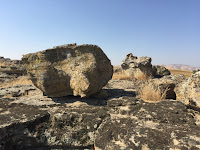One of my more interesting experiences since coming to
the Golden State was teaching Kindergarten. For the school year 2007-2008, I accepted a
Kindergarten assignment at San Juan School in the beautiful town of San Juan
Bautista. Located on Nyland Drive, San
Juan is a K-8 school and is part of the Aromas-San Juan Unified School District. This particular assignment was only my second
full-time year, and in the end proved one of the most exhausting years of my professional
experience. For one thing, I was living
in Merced at the time so I had a one-way commute of almost two hours (admittedly,
the commute was via CA 152 through Pacheco Pass, so as someone interested in
geology I couldn’t complain too loudly; not everyone gets the pleasure of a
daily drive that includes numerous road cuts through a Mesozoic subduction zone);
there were times when that extra three or four hours added to my work day was
unwelcome. For another thing, teaching
Kindergarten-aged kids is the most energy-intensive activity in the teaching
profession bar none, and even though being around them was emotionally refreshing, it was physically
exhausting. They were a really cute
bunch and they caught my heart on a daily basis, but you have to be “on” every
second you are around them, and their 10-second attention-spans left my head
spinning by the end of the day. By the
end of the year, I knew Kindergarten was too young an age group for me in terms
of future assignments; my current grade ranges are anywhere from Sixth through
Ninth.
 |
| My classroom is circled in blue (photo courtesy of Geology Cafe.com) |
I spent nine months working forty-hour work weeks
practically on top of one of the most famous and most studied geological
features on the planet. In the words of
my current group of students, it was “hella sick.” Needless to say, I did not neglect the
opportunity to become more familiar with the Fault and with some of the geology
of the surrounding region during my time there; several free afternoons meant for
“prep time” were spent exploring, especially in the early autumn and spring
when the days were fair. When weighing
“Zoophonics” against tectonics, the outcome was never in doubt.
When the Franciscans founded the mission of San Juan Bautista, they
chose the flat surface at the top of a gentle slope as the site upon which to
build their church and other mission structures, giving them as it did a view
over the flat of the valley. Unfortunately,
what they could not have known was the gentle slope was a fault scarp; they
were building their mission right on top of the main trace of what would later
be named the San Andreas Fault.
This has had some unfortunate consequences over the last
two centuries---founded in 1797, the original church was heavily damaged by
earthquakes in both 1798 and 1803, after which a new church was planned. The new church was designed to be stronger
and heartier to prevent earthquake casualties and damage, something which was
subsequently forgotten in California until after the hard lessons of 1906 were
learned. Even with the “earthquake
engineering,” the church was damaged (but survived) strong earthquakes in 1836,
1838, and 1868. It was heavily damaged
in 1906 (but rebuilt), and retrofitting enabled it to ride out the 1989 Loma
Prieta quake with minimal damage.
Because of its location along the Fault and its
tendency to experience quakes, and because the study of quakes and faulting really
took off after the 1906 disaster and subsequent Lawson report, the USGS chose
San Juan Bautista to place a monument commemorating its centenary in 1979.
It’s a charmingly understated monument to an
organization that has monitoring stations, laboratories, and staff that has contributed
to understanding of the Earth and its processes to such a large degree in its
short life span.
The Earthquake Walk not only follows the old El Camino
Real as it passes the Mission, it lies on the fault scarp. The stairs in the photograph descend the
scarp, itself, and stepping down them and walking the path allows you to
experience treading on a strike-slip fault with three different directions of
movement relative to each other. On the
top of the slope before descending, the movement is to the north and west
relative to the Valley floor at the base of the slope. There is also vertical movement; the hilltop where the Mission is perched is over
70 ft. above the surface of the Valley it was once level with (vertical
displacement was documented here after the 1906 rupture). Of course, it hasn’t gained that much
displacement in historical time; it accumulated over the last 20,000 years or
so. Still, it’s a pretty impressive
impact over what (in terms of geological time) amounts to the blink of an eye.
Other than the Walk there are other traces to be found
in San Juan Bautista but they are very subtle, and as is to be expected the
damage of previous fault ruptures has been repaired in subsequent years. The people of the town are not unaware of the
significance of their location; there is a restaurant right on the scarp called
The Fault Line, and the town boasts a first-class mineral shop called
TOPS/Jan’s Rock Shop which hosts Fault Walks.
Even without such obvious clues, it is impossible for the town’s
population to ignore the temblors the town experiences. Indeed, one afternoon while sitting at my desk
doing class prep after the kids had gone home, I experienced one such that was
at least 3.5 on the Modified Mercalli Scale.
While it was not my first quake experience, it was my strongest and
coolest to date and I enjoyed it thoroughly.
Sources
Jenkins, Olaf P.
Plesitocene Lake San Benito. California
Geology, vol. 26, No. 7, July, 1973.


















